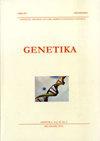植物病原菌sordida微卫星标记的遗传多样性研究
4区 农林科学
Q3 Agricultural and Biological Sciences
引用次数: 0
摘要
采用MP-PCR技术对不同地理区域和寄主分离株的遗传多样性进行了研究。PCR扩增使用8个引物。其中,只有4条引物[(ATC)7、(ACTG)4、(CGA)5、(AAC)8]产生多态性条带。4条引物的多态性至少为88.5%,(ACTG)4引物的多态性最多为97%,UPGMA算法构建的树图中可分辨出3个可诊断群(1、2、3)。结果表明,分离株间存在较高的多态性,证实了MP-PCR标记在种内水平上研究索氏弧菌分离株遗传变异的价值和准确性。我们没有发现所观察到的遗传多样性与分离物的地理区域或寄主植物之间的任何相关性,除非在有限的情况下。真菌性态在树木感染部位的丰富形成以及无性繁殖过程中可能的无性重组是个体间高度遗传变异的影响因素。本文章由计算机程序翻译,如有差异,请以英文原文为准。
Genetic diversity of plant pathogen valsa sordida using microsatellite markers
The genetic diversity of Valsa sordida isolates from different geographical regions and hosts was investigated using MP-PCR markers. PCR amplifications were done using eight primers. Of them, only four primers [(ATC)7, (ACTG)4, (CGA)5, and (AAC)8] produced polymorphic bands. At least 88.5% polymorphism was revealed by four primers and the maximum polymorphism (97%) was generated by (ACTG)4 primer and three diagnosable groups (1, 2 and 3) were resolved in the resulting dendrogram constructed by the UPGMA algorithm. The results showed high polymorphism among the isolates and confirmed the merit and accuracy of the MP-PCR markers for studying the genetic variability of V. sordida isolates at the intra-species level. We have not found any correlations between observed genetic diversity and the geographical region or host plant of the isolates, unless in limited cases. The abundant formation of the sexual state of the fungus in the infected parts of trees, as well as possible asexual recombination during asexual reproduction, are suggested as influencing factors of high genetic variability among the individuals.
求助全文
通过发布文献求助,成功后即可免费获取论文全文。
去求助
来源期刊

Genetika-Belgrade
AGRONOMY-GENETICS & HEREDITY
CiteScore
1.80
自引率
0.00%
发文量
1
审稿时长
6-12 weeks
期刊介绍:
The GENETIKA is dedicated to genetic studies of all organisms including genetics of microorganisms, plant genetics, animal genetics, human genetics, molecular genetics, genomics, functional genomics, plant and animal breeding, population and evolutionary genetics, mutagenesis and genotoxicology and biotechnology.
 求助内容:
求助内容: 应助结果提醒方式:
应助结果提醒方式:


